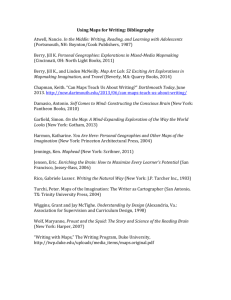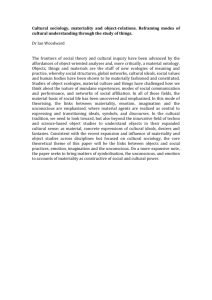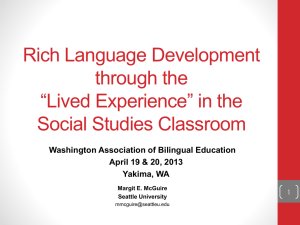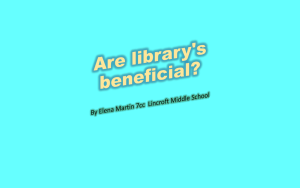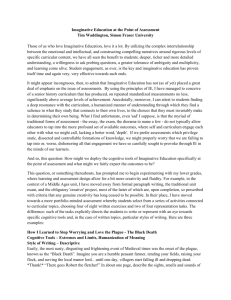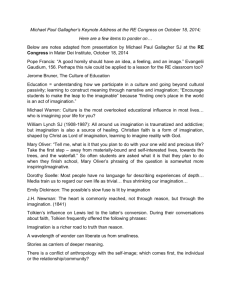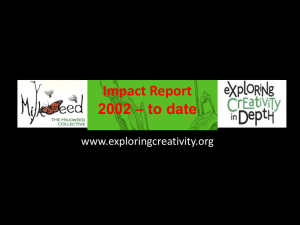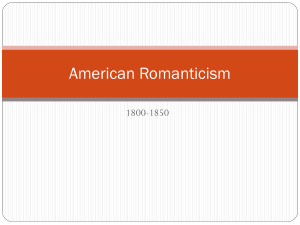van Alphen Peter, 2015, Bringing Emotion into Learning through
advertisement
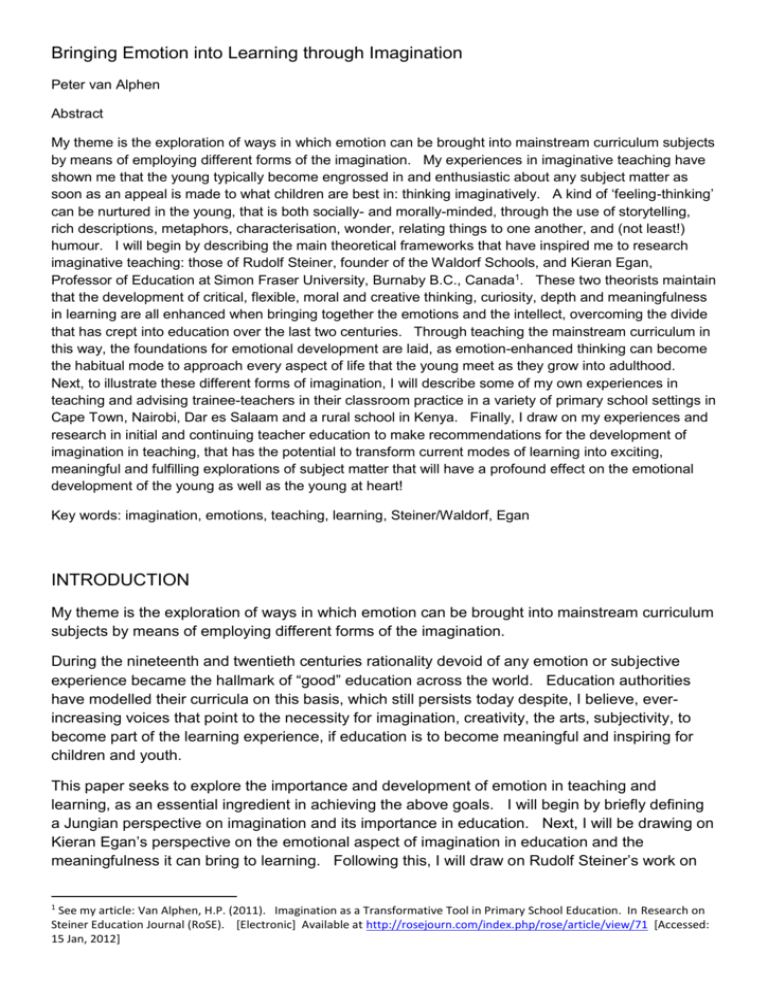
Bringing Emotion into Learning through Imagination Peter van Alphen Abstract My theme is the exploration of ways in which emotion can be brought into mainstream curriculum subjects by means of employing different forms of the imagination. My experiences in imaginative teaching have shown me that the young typically become engrossed in and enthusiastic about any subject matter as soon as an appeal is made to what children are best in: thinking imaginatively. A kind of ‘feeling-thinking’ can be nurtured in the young, that is both socially- and morally-minded, through the use of storytelling, rich descriptions, metaphors, characterisation, wonder, relating things to one another, and (not least!) humour. I will begin by describing the main theoretical frameworks that have inspired me to research imaginative teaching: those of Rudolf Steiner, founder of the Waldorf Schools, and Kieran Egan, Professor of Education at Simon Fraser University, Burnaby B.C., Canada1. These two theorists maintain that the development of critical, flexible, moral and creative thinking, curiosity, depth and meaningfulness in learning are all enhanced when bringing together the emotions and the intellect, overcoming the divide that has crept into education over the last two centuries. Through teaching the mainstream curriculum in this way, the foundations for emotional development are laid, as emotion-enhanced thinking can become the habitual mode to approach every aspect of life that the young meet as they grow into adulthood. Next, to illustrate these different forms of imagination, I will describe some of my own experiences in teaching and advising trainee-teachers in their classroom practice in a variety of primary school settings in Cape Town, Nairobi, Dar es Salaam and a rural school in Kenya. Finally, I draw on my experiences and research in initial and continuing teacher education to make recommendations for the development of imagination in teaching, that has the potential to transform current modes of learning into exciting, meaningful and fulfilling explorations of subject matter that will have a profound effect on the emotional development of the young as well as the young at heart! Key words: imagination, emotions, teaching, learning, Steiner/Waldorf, Egan INTRODUCTION My theme is the exploration of ways in which emotion can be brought into mainstream curriculum subjects by means of employing different forms of the imagination. During the nineteenth and twentieth centuries rationality devoid of any emotion or subjective experience became the hallmark of “good” education across the world. Education authorities have modelled their curricula on this basis, which still persists today despite, I believe, everincreasing voices that point to the necessity for imagination, creativity, the arts, subjectivity, to become part of the learning experience, if education is to become meaningful and inspiring for children and youth. This paper seeks to explore the importance and development of emotion in teaching and learning, as an essential ingredient in achieving the above goals. I will begin by briefly defining a Jungian perspective on imagination and its importance in education. Next, I will be drawing on Kieran Egan’s perspective on the emotional aspect of imagination in education and the meaningfulness it can bring to learning. Following this, I will draw on Rudolf Steiner’s work on 1 See my article: Van Alphen, H.P. (2011). Imagination as a Transformative Tool in Primary School Education. In Research on Steiner Education Journal (RoSE). [Electronic] Available at http://rosejourn.com/index.php/rose/article/view/71 [Accessed: 15 Jan, 2012] 2 the importance of emotion in learning, how it may be evoked and the effects on children’s wellbeing. Finally, I will be drawing on my own experience as an advisor for teachers in their classroom practice and work as a teacher educator. This paper will limit itself to teaching and learning in primary school settings, though much of what is written may well inform pre-school and secondary settings, adjusting the methods used according to age-related needs. THEORETICAL FRAMEWORKS Imagination as Living Experience Bernie Neville (1989:12), in Educating Psyche: Emotion, Imagination and the Unconscious in Learning, makes the case that genuine learning happens through experience rather than by transmission of knowledge : … I have come to believe that we learn very little by being told the answers to questions we have not asked. Learning originates in the actions of the learner, not those of the teacher. A great deal of what we learn we learn by a sort of absorption, or we just ‘pick it up’ through experience, as we go along, without the need for teaching. It is only in schools that we abandon this natural way of learning. The crucial idea expressed here is that we learn best through experience. Neville draws on Carl Jung’s perspective that ‘every psychic process is an image and an imagining’, and that we recreate reality within ourselves from every experience that comes to us from the outside through the senses. (Jung, 1953:6, 11, 78, 889, quoted in Neville1989:9) Whenever something is presented to us imaginatively – by means of story, metaphor, vivid description, and the like – we create images of its content inwardly, within ourselves. From Jung’s statement it follows that the effect of imagination can be seen as similar to that of direct experience: the story, metaphor and vivid description are ‘lived experiences’, the source being our own creation of images rather than based on what arises from outer ‘lived experiences’. Imagination, then, is a living, inner experience which we actively create within ourselves. Generally, it is stimulated by perception of a creative, interest-arousing nature that is intensely meaningful to us. Returning to the quotation from Neville above, learning needs to be experiential to have value. The use of imagination can bring about a highly experiential form of learning, in which students are creatively involved, picturing the content for themselves through their own efforts. Imagination, being a ‘whole’ experience of thought, emotion and intentionality, is therefore a ‘living experience’, in the same way that meaningful events in our lives are lived experiences. 3 ‘Direct’ and ‘Indirect’ Methods of Learning Carl Jung makes a clear distinction between ‘directed’ thinking, which is based on reality, and ‘non-directed’ thinking, being “the unconscious, operated ultimately as an archaic reservoir of human history”, being an ‘objective stratum’ that expresses itself in images and feelings. (Matthews and Liu, 2008:17-18) Jung describes directed thought as: … evidently directed outwards, to the outside world. To that extent, directed or logical thinking is reality-thinking, a thinking that is adapted to reality, by means of which we imitate the successiveness of objectively real things, so that the images inside our mind follow one another in the same strictly causal sequence as the events taking place outside it. (Jung, 1956[1952]:para.11, quoted in Matthews and Liu, 2008:18) Translating this into educational terms, Neville (1989:15) defines purely intellectual teaching as “… a particular style of teaching we might call ‘direct’. … Good direct teaching successfully transfers information from teacher to student, generally thought to be a rational, intellectual operation.” Our education systems are based on a positivist, reductionist form of learning. “This onesidedness in conventional teaching makes it not only narrow but ineffective … This is not to diminish intellect, which is largely the instrument of our exploration,” (Neville, 1989:7, 11) but suggests that the idea of ‘indirect’ methods of teaching, appealing to the ‘unconscious’, need to be incorporated for successful teaching. (Neville, 1989:15) The ‘Unconscious’ in Learning Carl Jung’s view on the human psyche is two-fold: that of the conscious mind and the unconscious. He regards the unconscious as both that limitless store of collective garnering of human history, as well as that ‘driving force’ towards development, evolution working actively in each human being. (Matthews and Liu, 2008:17) Individuation is a vital process in the human being, which requires the integration of the unconscious with the conscious. This integration is effected by means of images and feelings – the contents of the unconscious need to feed into the conscious for the personality to be whole and for development towards ever increasing maturity to take place. (Matthews and Liu, 2008:1718) In educational terms, ‘direct’ thinking therefore needs to be integrated with ‘non-direct’ thinking: A counterbalancing respect for the imagination is vital for the healthy psychic system as through it, ‘directed thinking is brought into contact with the oldest layers of the human mind, long buried beneath the threshold of consciousness’. (Matthews and Liu, 2008:19, quoting Jung, 1956[1952]:para.38) Incorporating the unconscious, through use of the imagination, is vitally important in the classroom, to allow students to experience an integration of their inner selves with what they are learning about the outer world. Through this they will enact the process of ‘recognition’ of knowledge, all knowledge being already existent in the unconscious, at 4 least in archetypal form. This recognition of truth is a matter of it being brought from the unconscious into the conscious mind, a process that is enormously facilitated by using the language of the unconscious: that of images and feeling. Imagination and Truth Jung “looked to images not as hiding reality (as Freud perceived them) but as revealing it.” (Neville 1989:90) Imaginative teaching therefore needs to arise out of truth: otherwise it is fantasising, which has no effect on learning as the topic presented cannot be found in the images that are present in the unconscious. This means that a thorough understanding is needed of the topic, so that the corresponding images from the unconscious may arise, bringing a fullness of experience of the particular topic. When this takes place, the object or principle studied finds its ‘ecological’ place in the field of knowledge, integrating in the whole. The topic therefore becomes immanently meaningful, advancing the process of individuation in the individual. ‘Burn-out’ in learning The one-sided, purely intellectual learning of subject matter is an unhealthy activity, failing to nourish the psyche of the individual. According to Jung, directed thinking is “prone to tire”, taking “significant conscious effort to maintain, as ego has only a limited portion of the psyche’s libido at its disposal.” Non-directed, or fantasy-thinking, on the other hand does not tire the ego, “working as it were spontaneously, with the contents ready to hand, and guided by unconscious motives”. (Matthews and Liu, 2008:18, quoting Jung, 1956[1952]:para.11) This is highly significant, as teachers find it more and more difficult to maintain student’s attention and enthusiasm for learning when using conventional, purely intellectual approaches, as will be discussed in the next section. Kieran Egan’s View of Imagination We now turn to the work of Kieran Egan, whose theory of imagination is based on a combination of children recapitulating the cognitive tools in the order in which humankind developed these, with Vygotsky’s socially mediated intellectual tools. …NEEDS INTEGRATION/ELABORATION Egan (IERG, 2008) describes imagination as a “cognitive tool” that is central to the development of the human mind. In the beginning of life, cognition is somatic: we learn through bodily experience. With the development of language comes what he terms a “Mythic” phase, comparable to the oral cultures of early humans. This phase has particular characteristics: thinking in terms of binary opposites (e.g. good and evil), the basis of stories that appeal so directly to children 5 fantasy, which tell of lives in imaginary realms, where magical events can take place metaphor, going beyond the literal naming of objects and events, making links with other ideas to represent the topic under discussion rhythm and rhyme, which create patterns that captivate young children and are easily remembered through repetition images, which vivify knowledge and concepts, enriching them abstract thinking, though not conscious in young children, they understand everything due to a higher order of thinking within which all concepts have a meaningful place humour, based on a play of words, which help to increase sophistication in language use (Egan 1997, p. 211) stories, which make use of many of these characteristics. When literacy begins, a new development in cognitive tools takes place, from around 5 or 6 years of age. This development does not displace somatic and mythic thinking, but builds on it. Egan refers to this as a Romantic phase, in which reality now demands a more rational way of thinking, yet still maintaining mythic characteristics: … between the myths that shape the world, to the requirements of mental structures and theories that try to conform with the actual structure of the world, we have romance. Romance deals with reality, but it does so with persisting mythic interests. It is a compromise with, rather than a capitulation to, reality. (Egan 1997, p. 86) To illustrate the characteristics of the cognitive tools in this phase, some examples are given (Egan 2005:78-80): sense of reality, in which reality is presented through vivid stories and anecdotes, the amazing and the extraordinary, leading the young towards a rational understanding of reality over time. (Egan 1997, p. 86) association with heroes, who are able to overcome the constraints of reality, and embody transcendent qualities such as selflessness, ingenuity, patience humanised knowledge, in which knowledge is presented in the lives of discoverers and inventors, the emotions experienced in their struggles and achievements sense of wonder, through which we can recognise the wonderful in every feature of the world and see its particular uniqueness collections and hobbies, in which immense intellectual energy is put into collecting a set of something or pursuing a hobby knowledge and human meaning, to see knowledge in terms of human meaning, through the emotions involved in its creation 6 Emotions in learning During the twentieth century the underlying belief held by education was that intellect and emotions should be kept separate, and that schooling was responsible for the intellectual part only. This split, according to Egan, had a destructive effect due to learning becoming devoid of human emotion. This resulted in “learning becoming of only utilitarian value, destroying much that is valuable in our lives,” bringing about a “dessicated” type of rationality. It is imagination that can overcome this split, and bring meaning back into teaching and learning (Egan 2007:18): Taking imagination seriously in education directs us to transcend the intellect/emotion split and perceive both together in all areas of knowledge and all aspects of education. (Egan 2007, p. 19) Stories In Teaching as Storytelling (1986:29), Egan makes the point that stories clearly demonstrate that “we make sense of the world and experience ‘affectively’ no less than ‘cognitively.’” Emotion and cognition work together simultaneously. Using ‘story form’ in day-to-day teaching will therefore provide “a more balanced appeal to children’s learning capacities.” Storytelling was the education of earliest times. The contents of stories were easily remembered, ensuring the continuance of the tribe’s knowledge and culture. At the same time, the emotions were intrinsically tied into these contents, so that they “orient the hearer’s feelings about the information communicated.” (Egan, 2005:10) The ability of stories to stir the emotions, tying the feelings aroused to the contents of the story, made it the most powerful tool for educating the tribe’s members in their culture of living and knowing. (Egan, 1997:62-64) Stories therefore, as the most effective cognitive tool for conveying knowledge in meaningful and memorable ways, could be used to great advantage in education: Instead of seeing math and science, for example, in terms of particular skills, knowledge and manipulations, we would see them as the greatest of human adventures, full of drama, hopes and disappointments, discoveries and inventions ... by seeing math and science not as disembodied pieces of knowledge or skill but as the inventions and discoveries of particular people, as products of their hopes and disappointments, their struggles and problems, we can begin to re-embed those subjects again in their proper human contexts, in which they initially had affective, as well as purely cognitive, meaning. (Egan 1997:64) Similarly, in learning language, children will respond particularly to stories. Egan (1997:68) recommends that “[t]he most important, dramatic and vivid stories of our world and of human experience can provide an appropriate curriculum for the earliest years.” Pre- and primary school teachers therefore need to become “the storytellers of our culture,” continuing the age-old tradition of stories told around the fire as the earliest source of education. [The [newspaper] reporter is asked to select and organise the material in order to bring out the emotional and imaginative meaning of the topic. This is the 7 sense … in which teachers can use stories routinely in teaching any content, without fictionalising it in any way. For example, when teaching the spelling of the homophones there, their and they’re, the students “might be told that there is a new family in the neighbourhood and they have three children who are called, a bit surprisingly, There, Their and They’re.” (2005:12-13)] Images The use of images in education is another ‘tool’ that can be used effectively in teaching and learning. In listening to an imaginative introduction of a new topic, the act of creating images by the students carries “as powerful an emotional effect” as real events can do. This means that educators need to be conscious of the “vivid images that are part of every topic and to draw on them consistently in vivifying knowledge and concepts.” (Egan, 1997:60-61) The use of affective images avoids the tendency to reduce lesson content to its bare bones. Instead, their affective component helps young learners to relate to the lesson content, providing ... a means for the child to ‘incorporate’ it. This helps them to see that mathematics, history, and science are not made up of alien knowledge, something out there apart from them. By imaginatively grasping knowledge, children make it, reciprocally, become a part of them. So children discover that they are mathematical, historical, and scientific beings. (1997, p. 62; italics in original) [the images come along with an emotional colouring … Given the universality of imagegeneration in all oral cultures, it would be prudent to reflect on ways to use this cognitive tool in teaching. (2005:27)] [Humanised knowledge Finding a “human interest angle” is one of the techniques used by journalists to interest their readers in their news items. Teachers know how the telling of an anecdote, especially if it has emotional impact, can awaken the interest of their students. Egan (1997:92-94) argues that if knowledge can be linked to the emotions that were part of the discoverers’ and inventors’ struggles to achieve what they did, the students would likewise be touched, so they “also feel why someone might care about the structure of the universe, the behaviour of insects, the interactions of chemicals, and so on.” ] Imaginative teaching In Egan’s framework for planning imaginative lessons, the first question he poses is, “Locating Emotional Meaning: What is emotionally engaging about the topic? How can it evoke wonder? Why should it matter to us?” Taking a topic such as the butterfly, Egan (2005:48) suggests that one has to find what is important and emotionally engaging in the butterfly’s transformations. In order to “shape facts 8 into a (non-fictional) story form,” the binary opposites will help to bring out the emotional qualities inherent in this topic: … from the caterpillar that does almost nothing but eat, to the butterfly that eats nothing, only sips nectar; from the dull, narrow chrysalis to the bright-winged jewel of the air; from the largely immobile caterpillar to the butterfly that sometimes migrates more than a thousand miles; from the incessantly growing caterpillar to the butterfly that is unchanging after it emerges from the chrysalis … Knowledge about the butterfly gives us a vivid insight into the wonder of the forms of life on our planet.” (italics inserted) Wonder and emotion are completely intertwined. Accordingly, Egan suggests that teachers need to find their own emotional response to the material, asking them “to feel for what is wonderful about the topic.” (2005:53; italics in original) This needs one to “try to re-see the topic through the eyes of the child” so that the sense of wonder, and hence emotion, can be aroused. (idem) Meaningfulness in learning, therefore, arises out of enriching everything to be taught through the lenses of wonder and emotional involvement. In this way, learning will matter to children and “enrich their perception of the world … It can be affectively engaging through its power to evoke, stimulate and develop the sense of wonder and engage it with reality. (Egan, 2005:58) Romance Egan chooses the term “Romantic” understanding to show that rationality only gradually develops in children. Children, up to approximately 15 years of age, need to first “make sense of reality in ‘romantic’ terms” to facilitate their development towards rational thinking in an ageappropriate manner. (Egan 1997:102). …………………. check The aim is not to sensationalise learning. It is a development towards theoretic thinking, in that romance seeks to describe reality as it is, but appeals to the human emotions and intentions that are related to this reality; it appeals to the heroic, wonderful, amazing, exotic, transcendent and extremes inherent in a topic, as well as generating an intense interest in the details of particular events or phenomena. (Egan, 1997:254-255) Alienation from Learning The lack of the above elements inevitably causes disconnection with the material to be learnt, as its appeal and meaningfulness are missing. This brings about a feeling of alienation towards learning, as something ‘out there’ in which no personal involvement is generated, resulting in a ‘going through the motions’ of schooling. “Forms of teaching and learning that are disconnected from our emotions are educationally barren.” (Egan, 2007:19) Alienation is a serious phenomenon in modern (and post-modern) society, and one may regard the form of education that is generally applied as a significant contributing factor. This alienation directly affects the results of student achievements in schools: Much of our failure in mathematical and scientific understanding in schools may stem from the general failure to distinguish Romantic understanding and its 9 distinctive ways of engaging and making rational sense of the world as prerequisite to theoretic thinking. (Egan 1997:97) [Egan (1997, p. 52-53) states this as follows, regarding educational practice: Enormous emphasis has been placed on those intellectual skills that young children manage least well and develop only slowly - computational, logico-mathematical skills – with an equivalent neglect of what children do best - metaphoric, imaginative thinking.] Cognition, Emotion and Will We now turn to Rudolf Steiner’s understanding of the human psyche as threefold in nature: in his terms, ‘thinking’ (cognition), ‘feeling’ (emotion, affect) and ‘will’ (volition, intentionality, drive). These three aspects need to be integrated for a person to function intelligently, creatively, and morally. Steiner was particularly concerned about the Western tendency (now generally spread all over the world) to be able to think without engaging feeling and moral will. In his time (18611925), this tendency became more and more apparent, showing itself as rising exploitation, indifference, violence and criminality. To overcome this tendency, and provide a positive impetus to bring integration to individuals and society, he founded the first Waldorf School in Stuttgart, Germany in 1919, after the First World War. Today, this is a world-wide educational movement, spanning the education of three to nineteen-year-olds. Steiner argues that imagination unifies thought, feeling and will in the psyche of the individual, giving rise to a wholeness of experience. He states that “… when a thought is communicated … this thought is the germ both of a feeling and an impulse of will ...” (1954[1923]:75). This implies that when humans are actively engaged in imagination, images, emotions, and energy and enthusiasm for action are generated. Steiner drew the following diagram to show the circular effect of ‘imaginative cognition’ (an imaginative presentation of a topic) stimulating ‘inspired feeling’ (depth of emotional engagement), resulting in a stirring of the ‘intuitive will’ (enthusiastic participation in the activities that follow) which in turn gives rise to new, imaginative ideas (generated by the students in, for example, discussion that follows), causing the cycle to keep repeating itself: 10 Diagram 1 : Circular Effect of Cognition – Feeling – Will (simplification of Steiner 1996a[1919], p. 118) Here we see a method of ‘whole child’ education, in which a balance of head, heart and hands can be attained. ‘Intuitive’ will, given rise to by inspired feeling, refers to internal activity within students to work together in a harmonious, mutually beneficial way, being sensitive to each others’ needs and working together ‘for the common good’. ‘Feeling-thinking’ Steiner’s theory of education focuses especially on developing what could be termed ‘feelingthinking,’ that is, an integration of ‘head-thinking’ with ‘heart-thinking’. (1954[1923]:198) Children who are exposed to an imaginative form of learning, “do not merely ‘have an idea’ in their heads; they feel the idea, for it flows into their whole life of feeling.” (idem, italics inserted). In his time, Steiner saw that the lack of imaginative learning resulted in a tendency to superficiality in education. (idem) Knowledge was simply facts to be learned, in what he terms ‘finished concepts’, i.e. rigid thinking patterns that were rote-learned without any understanding of their implications, context, richness of meaning or depth of insight. In other contexts he referred to these as ‘fixed’ concepts which have no potential for growth. (Steiner, 1954[1923]:144) Children exposed to this kind of teaching, especially in the first school years, will become “blunted and dull.” (Steiner, 1996b[1923]:100) In contrast, when knowledge is presented in an imaginative way, cognition is suffused with emotion. This causes the formation of ‘flexible’ concepts, with potential for further growth that can bring more detailed, richer meaning and deeper insight into the topics in a spontaneous and natural way. (Steiner, 1954[1923]:144) The continual development of integrating head-thinking with heart-thinking is of vital importance, in which parents and teachers who care about a moral learning community (without ever having to consort to moralising) can work together. It takes a whole village to raise a child! (Afriprov., 1998) An example of emotion in an imaginative moment This example was observed by a fourth year B.Ed. student, Pippa Tyler, in doing her dissertation research on the following question: “What is a ‘connective moment’, and how can one begin to explain such moments in classroom learning?” She writes (Tyler, 2013:6,15), about a Grade 3 environment lesson: One of the tasks was planting cauliflower seeds into a seed tray. The gardening teacher phrased the instructions for planting the seeds in a very imaginative way. He compared a seed that he was holding in his hand to a tiny baby. Requesting input from the children, he asked how one treats and cares for a tiny baby. The children came up with answers such as: “Very gently”, “They need to feel safe”, “They need to eat all the time”, “They need soft clothes and blankets” etc. He then used their input to explain exactly how to plant the seed. He explained that they needed to fill each space in the seed tray half full with compost, without compressing the compost, because a baby needs a soft bed to sleep in. 11 He said that they must then gently sprinkle compost over the top of the seeds like a blanket, again not compressing it. He then told them how often they would need to feed “their babies”, and monitor their growth, etc. During this connective moment the gardening teacher compared a seed to a tiny baby, but he also used body language to convey what he meant. He held the seed carefully in a cupped hand, not pinched between thumb and forefinger, and he used his voice to denote gentleness and care. His attitude was one of wonder of growing things, and it was clear to me, and to the children, that he cared deeply about what he was doing. This small moment was quite profound for me because although the instructions could have been quite simple, the result of delivering them in this imaginative way was very noticeable. I was amazed that despite their excitement at being outside, and their usually exuberant natures, they treated the seeds with extreme gentleness and reverence. They followed the gardening teacher’s instructions exactly, and I felt that there was an understanding behind their actions that might not have been there if the teacher had given the instructions in a more straightforward way. Steiner (1954[1923], p. 165) has the following to say about the teaching of history in the years before the age of twelve: … [The child] must be able to enter into a personal relationship with historical figures and with the modes of life prevailing in the various historical epochs … everything we say must enter the domains of feeling and will in the child. He must himself be able to live in the events, to form himself within them by the way they arouse his own sympathies and antipathies. [italics inserted] [ … every topic has some kind of dramatic conflict in it … for the teacher, trying to feel the drama is as important as thinking about it. We are so accustomed to thinking about content, and about concepts, that we often forget that every topic also has a wide range of images attached to it. … the image … can carry the emotional meaning of the topic and can also make the topic much more memorable – if you find a good image, of course. (Egan 2005:54-55) ] My experiences in imaginative teaching have shown me that the young typically become engrossed in and enthusiastic about any subject matter as soon as an appeal is made to what children are best in: thinking imaginatively. A kind of ‘feeling-thinking’ can be nurtured in the young, that is both socially- and morally-minded, through the use of storytelling, rich descriptions, metaphors, characterisation, wonder, relating things to one another, and (not least!) humour. . I will begin by describing the main theoretical frameworks that have inspired me to research imaginative teaching: those of Rudolf Steiner, founder of the Waldorf Schools, and Kieran Egan, Professor of Education at Simon Fraser University, Burnaby B.C., Canada2. These two theorists maintain that the 2 See my article: Van Alphen, H.P. (2011). Imagination as a Transformative Tool in Primary School Education. In Research on Steiner Education Journal (RoSE). [Electronic] Available at http://rosejourn.com/index.php/rose/article/view/71 [Accessed: 15 Jan, 2012] 12 development of critical, flexible, moral and creative thinking, curiosity, depth and meaningfulness in learning are all enhanced when bringing together the emotions and the intellect, overcoming the divide that has crept into education over the last two centuries. Through teaching the mainstream curriculum in this way, the foundations for emotional development are laid, as emotion-enhanced thinking can become the habitual mode to approach every aspect of life that the young meet as they grow into adulthood. Balance of Imagination and Concept The observant and sensitive teacher sees and responds to this inward movement in her pupils. As she presents and explains a concept which is new to her class, she notices the engagement and puzzlement of those pupils in whom her words find some resonance as they search within their subjective inchoate knowledge , for the point at which they already know what the teacher is talking about. She knows the delight of seeing the light come into her students’ eyes as her concept begins to make sense. She notices also the blankness in the faces of those for whom her words are only words, who if they carry her words downwards and inwards find they have nowhere to place them. So the teacher searches for new words and new images and tries again to connect with what the children already know darkly. When she succeeds she is immediately rewarded. (Neville, 1989:17) This movement from the outer to the inner and back again is a basic human rhythm. In an extroverted society like ours there is some danger that we will override this rhythm and neglect these necessary moments of inwardness. … What many teachers overlook is that children also need the opportunity to turn inward, not only to grow as balanced, healthy individuals but also to learn effectively what they are being taught. (Neville, 1989:18) Rich Detail for Rich Imagination Precision is difficult to achieve, but the attempt does her [Psyche] honour. The natural language of Psyche is metaphor, and we may get our best understanding of psyche by layering metaphor upon metaphor. This is not vagueness. It is, at best, a peculiarly subtle form of precision. (Neville, 1989:18) Wonder One of the questions I find too hard is how the process of teaching and learning is related to questions of ultimate meaning …The children pick up their notions of meaning while studying literature, science, art, technology, history, politics, music, mathematics. They are lucky if they have a teacher who is sensitive to such questions. They are even luckier if their teacher has the skills to help them articulate and explore the vague notions which emerge. (Neville:1989:19) EXPERIENCES IN ADVISING TEACHERS IN SOUTH AND EAST AFRICA 13 Next, I will describe some of my own challenges in teaching and advising trainee-teachers and practising teachers in their classroom practice in a variety of primary school settings in Cape Town, Nairobi, Dar es Salaam and a rural school in Kenya. First, I would like to make a general comment, namely, that whenever I observe a teacher presenting lesson material in a factual manner, generally taken from text books, and lacking in detailed description or employing one or more imaginative tools (as in Egan above), the concentration and interest span of the children is limited. In observing the effects of this kind of teaching on children, very soon they tend to disconnect with the learning process in hand and pass into daydreaming, fidgeting, playing with items on or below their desks or worse, starting to misbehave. As soon as a teacher brings in something that arouses their interest, appealing to their imagination, they engage with the material presented, in the many varied ways in which children do! Recall of the material thus presented the next day is full of detail, as if re-experiencing a favourite story. Clearly emotional participation is present, in the way they absorb the input from the teacher, and the way the recall is given: not as bland intellectual content, but as intellectual content spoken with feeling, as living experience. Challenges in Facilitating the Development of Imagination In advising teachers at work with children in their lessons, I am confronted with the difficulty of facilitating teachers to become more imaginative in their presentation of topics from the curriculum. Of course, there are exceptions to this generalisation: it seems that these have had a childhood in which imagination has played a roll. For example, some of the teachers I interviewed have had a rich experience of hearing stories from the Bible or within other religious faiths. Others have read extensively, mostly fiction novels, as they grew up. A few had poetry lessons that inspired them, and kept their love of poetry alive. Likewise, a few may have been involved in the creative arts. However, many of those who did not have these privileges, struggle to become imaginative. I have found that there are two aspects to this struggle. The first is that of the teacher’s own lack of emotional capacities: here I have used both myself, my own subjective nature, as an instrument of perception (…………..), as well as observing the responses of the children. Where the teacher’s relationship towards the children is lacking in feeling, there seems to be a lack of cohesion amongst the children. The room feels ‘cold’. The motions of teaching are gone through, but learning is not a warm, social experience, in which the children feel ‘at home’. The children participate minimally. The result was that soon the children became unmanageable, because they were not ‘held’ by the teacher. In such cases, I have spoken with the teacher, asking her (it could equally have been a male teacher) to be ‘warmer’ towards the children, in how they speak and relate to them, so they feel connected to her. In some cases the teacher can maintain the effort to continually, consciously feel greater warmth towards the children in her care, until it becomes ingrained habit. In other cases, the teacher falls back into the default position that she is used to. The ability to change …..??????? 14 The second aspect is that despite including imaginative exercises in their training, when the teachers are with their children, many tend not to use what they have learnt. Instead, they return to the way in which they were taught themselves at school, which in most cases had been reinforced in their college training (of the old apartheid or colonial era) or a one-sidedly rational university education. It is as if they automatically return to their ‘default setting’. Fettes (n.d.:6) describes three causes as to why student-teachers (the same, I would suggest, applies to practising teachers) find difficulty in making a transition to imaginative teaching: First, they had not been exposed to it themselves Second, the method requires that the teacher herself be imaginatively engaged in the topic, retaining a sense of wonder and intellectual excitement that few of our students associated with the curriculum Third, the teacher needs to know the topic well enough and have sufficient confidence in her classroom management abilities, to allow considerable freedom of exploration to the children My experience is that the best starting point for teachers-in-training is to start with the most accessible form of the imagination. The reading and telling of stories, particularly traditional stories of the kind that Jung regards as embodying archetypal images and which are spread all over the world, across different cultures, brings the adult back into the richness of the oral traditions of our ancestors. In my own case, the extensive telling of these stories over long periods of time, opened my mind to regaining my childlike imagination, and with it, the playfulness of mind that is so delightful in children. And so, the student-teachers that I have interacted with in their teacher education programmes, mostly have become tellers of stories to their classes, following the Steiner’s suggestion of stories suitable for each stage of a child’s development. (See van Alphen, C., 2011). This ensures that children’s imaginations and their emotional development are, at least to some extent, cared for. Teacher Education and Continuing Development Programmes However, further steps are needed to more fully transform teaching from direct transmission to imaginatively experiential learning of subject contents. This presents an enormous challenge, one that I am researching continually. How is it possible to facilitate the regular, daily use of the many imaginative tools outlined by Egan above? It seems to me that sustained practice over a long period of time is needed. In the first place, a thorough understanding of imagination, its nature and its variety of forms, leading to an understanding of emotion in imagination, is needed. This needs to be followed with regular practice until it becomes habit to find the emotional and imaginative possibilities in each and every aspect of curriculum content. 15 Supportive activities can do much to break the mould of the past: extensive experiences in the arts - drama, music, creative movement, recitation and writing of poetry, painting, drawing and clay modelling - help both in the activity of thinking ‘outside the box’ and in the exploring and cultivation of the emotions in different domains. Philosophical enquiry - regrettably a scarce item in the schooling system - is essential to help to break down the rigidity that has been imposed through rote learning and textbook education. Like imagination and awareness of emotion, it needs continual practice, mutually benefitting the teacher’s ability in all these areas of personal development. In Conclusion The above are areas of research that need urgent attention for the sake of making school education far more engaging for children. The loss of potential through the lack of experiential, creative learning is enormous in our society, and the sooner we can work together to overhaul educational practice, the sooner our societal malaises can begin to go through a process of transformation. Transforming teaching can do an enormous amount towards transforming society and meeting the needs of an ever-changing future! LIST OF REFERENCES Afriprov. (1998). African Proverbs, Sayings and Stories. [Online] Available at http://www.afriprov.org/index.php/african-proverb-of-the-month/23-1998proverbs/137november-1998-proverb.html [Accessed 14/04/2013 Egan, K. (1986). Teaching as Story Telling. Chicago: University of Chicago Press Egan, K. (1997). The Educated Mind. How Cognitive Tools Shape our Understanding. Chicago & London: University of Chicago Press Egan, K. (2005). An Imaginative Approach to Teaching. San Francisco: Jossey-Bass Egan, K. (2007). Imagination, Past and Present. In Teaching and Learning Outside the Box. Editors Egan, K.; Stout, M.; Takaya, K. New York: Teachers College Press. Fettes, M. (n.d.). Imagination and Transformation in Teacher Education. Retrieved from http://www.ierg.net/assets/documents/publications/Imagination%20in%20Teacher%20Ed .doc [Accessed 05/02/2013] Jung, C.G. (1953). Collected Works. Princeton University Press Neville, B. (1989). Educating Psyche: Emotion, Imagination and the Unconscious in Learning. Melbourne, Australia: Collins Dove. Matthews, R. S. and Liu, C.H. (2008) Education and Imagination: A Synthesis of Jung and Vygotsky. In Jones, R. A., Clarkson , A., Congram, S., and Stratton, N. (Editors, 2008). 16 Education and imagination: Post-Jungian Perspectives. Hove, East Sussex, UK: Routledge Steiner, R. (1954 [1923]). A Modern Art of Education. Stenographic transcripts of lectures, unrevised by the author, given in Ilkley, England, 5th – 17th August, 1923. London: Rudolf Steiner Press. Steiner, R. (1996a [1919]). The Foundations of Human Experience. Stenographic transcripts of lectures, unrevised by the author, given in Stuttgart, Germany, 20th August – 5th September, 1919. Great Barrington, MA: Anthroposophic Press. Steiner, R. (1996b [1923]). The Child’s Changing Consciousness as the Basis of Pedagogical Practice. Stenographic transcripts of lectures, unrevised by the author, given in Dornach, Switserland, 15th – 22nd April, 1923. Hudson, NY: Anthroposophic Press. van Alphen, C. & van Alphen, P. (2011). Child Development. Based on the Insights of Rudolf Steiner and as used in Waldorf / Steiner Schools. Open Source. [Online] Available at http://www.entwicklungshilfe3.de/projekte/themen/kreative-bildung/kenialehrerinnenfortbildungteachers-training/ [Accessed 15/04/2013] A curriculum without emotional relevance tends to become an exercise in rote learning and regurgitation (Fettes 6) Egan (2005:53) Especially when teachers have been taught to become expert at organising classroom activities and structuring topics into instructional units, this can be hard. It asks the teacher to do something that is probably quite unfamiliar – to begin by feeling about the topic. Try to indicate for any topic you plan to teach what is wonderful about it , what can give a child an emotional engagement to it. Changing to this form of imaginative teaching often turns out to be more difficult than it first appears … it is students’ emotional responses that we are centrally concerned with, not just their conceptual grasp of the logic of content. But … for this alternative approach to work in the classroom, the teacher’s own emotional engagement with the content must become central too. (Egan 2005:213-214)
